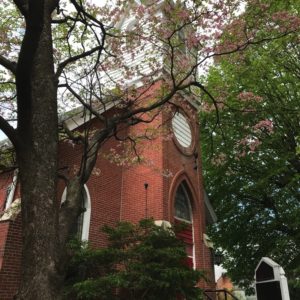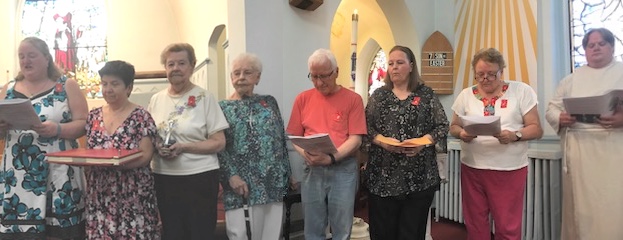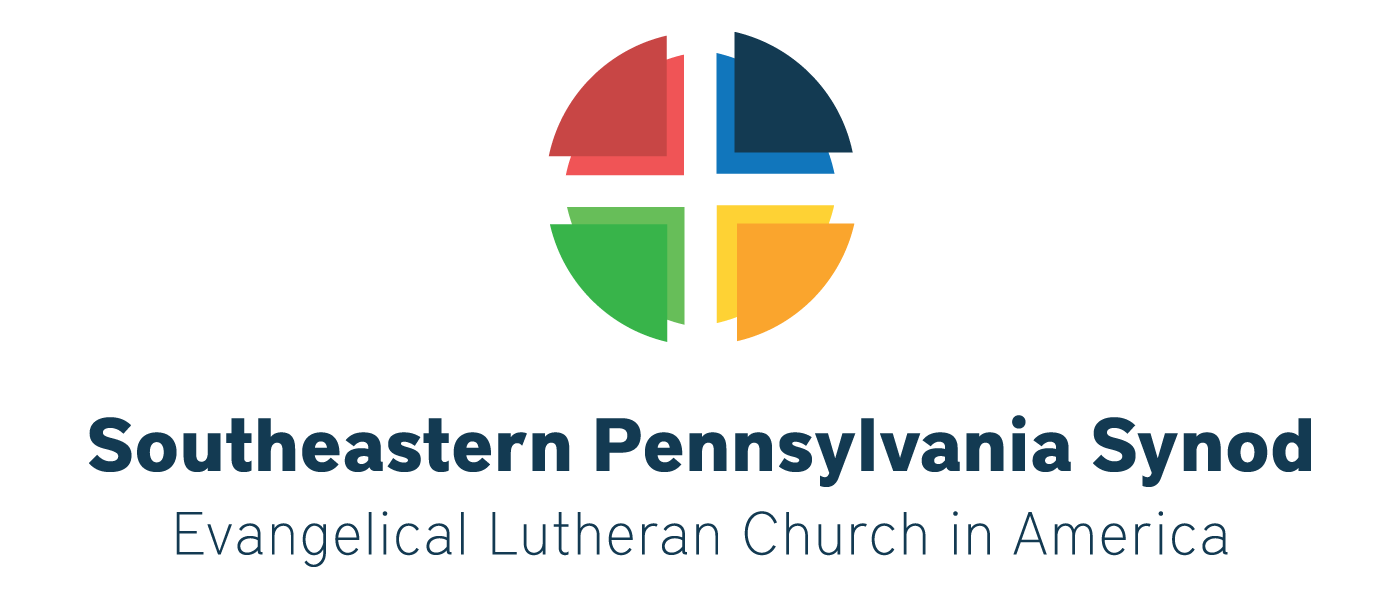June 2, 2019 in Congregations
Holy Closure: St. Petri-Hope

Remembering in prayer the saints at St. Petri-Hope Evangelical Lutheran Church.
St. Petri-Hope Lutheran Church, a congregation in the NE/W Philadelphia Conference, held its final worship service on Sunday, June 2 at 3 pm with Bishop Davenport presiding.
The service was attended by 152 saints.
An offering of $880 was received to benefit the Feast of Justice feeding ministry.
- Download: Remembering in prayer the saints at St Petri-Hope
- Scroll down for congregation history.

Senior Accountant and Property Manager Martin Schwab receives congregational records as Bishop Davenport and the Rev. Jane Marston, dean of the conference, look on.
Remembering in prayer the saints at St. Petri-Hope Evangelical Lutheran Church.
St Petri-Hope Lutheran Church, a congregation in the NE/W Philadelphia Conference, will hold their final worship service on Sunday, June 2 at 3 pm with Bishop Davenport presiding.
Rostered leaders and members of the SEPA Synod are welcome to attend the final service at St Petri-Hope as we celebrate the life, witness and service of this congregation to the Northeast Philadelphia community since 1891. Rostered leaders not participating in worship leadership are invited to sit in the congregation.
History of St Petri-Hope Evangelical Lutheran Church
The combined history of Immanuel German Evangelical Lutheran Church, St Petri Evangelical Lutheran Church and Hope Evangelical Lutheran Church
Immanuel German Evangelical Lutheran Church and St Petri Evangelical Lutheran Church
On June 20th, 1891, the Reverend Matthias Schimpf, Pastor of Immanuel German Evangelical Lutheran Church in Frankford along with organist, William H. Mann, visited the German Lutherans of Tacony at the request of the German Mission Committee of the city. Mr. Heinrich Diehl of Tacony helped Pastor Schimpf to contact the families who had declared themselves ready to form a congregation of their own. Facilities at the Tacony Music Hall were donated and the first Worship Service was held on July 5th, 1891 at 4pm. The organist and choir of Immanuel Frankford led the singing. A decision was made the following week to hold worship services every Sunday at 3 pm and The Tacony Music Hall was rented for three months for the sum of
$25.00. Two dozen hymnals were ordered. A provisional congregation was formed on July 21st, 1891 along with elected officers and a Ladies Aid. On that same day, a church choir with twelve members was begun. Financial support came from the generosity of congregational members and offerings at worship. By the end of that year the congregation had reached twenty-four.
Church records show that the Ladies Aid Society, from the beginning and through all the years, bore a large part of the financial burden. The ladies made and sold soup, realizing $15 – $20 each time.
As the time came for finding a permanent home for the congregation, a building committee was formed August 25th, 1891. Mrs. Mary Disston donated two lots and purchased a third lot for $375.00. The Sunday School was formed on September 20th, 1891. The following spring, on March 8th, 1892, the constitution and the by-laws were adopted and an application for synodical membership was submitted.
On June 14th, the Ministerium of Pennsylvania at Reading approved the application and a contract for the church was signed on July 20th, 1892. Ground breaking occurred on July 20th, the “hottest day of the summer”. The work of making our congregation an official body continued by having its charter granted by the Commonwealth of Pennsylvania on July 28th, 1892. Progress on the building continued and the cornerstone was laid on August 2nd. The completed church was dedicated only six months later on January 29th, 1893, and the first church council was elected May 1st. This entire development took place under Pastor Schimpf, for whom there is no record of remuneration. On June 13th, 1893, Pastor Schimpf resigned, feeling it was time for us to have our own Pastor.
One month later on July 25th, 1893, the congregation elected its first Pastor, the Reverend Andreas Biemueller who began his tenure September 20th, 1893. He served the areas of Wissinoming and Bridesburg in the south and as far as Bristol to the north. This continued until February 1919 when the Bristol congregation was incorporated into the Tacony congregation. In August of 1895, the decision was made to build a parsonage at a cost of $2,650.00. Under Pastor Biemueller’s guidance, the congregation continued to move forward. Although an educational building wasn’t constructed for another sixty-five years, it was already dreamed of by Pastor Biemueller as early as 1895. In 1904, the church bell was donated by the Sunday School. In 1910, the Men’s and Young Men’s Societies were formed and finally, in 1919, a new pipe organ was purchased and installed. Pastor Biemueller served with faithfulness and dedication for forty-one years until his death on November 26th, 1934. The congregation’s deep affection for Pastor Biemueller is expressed in the stained glass window behind the altar dedicated to his memory.
On February 3rd, 1935, the Reverend Henry W. Harms, arrived in Tacony to succeed Pr. Biemueller as Pastor. He was installed June 2nd, 1935. Within six months, under his direction, major changes had begun. Remodeling and renovation of the church included a full size basement, an oil heating furnance, an up-to-date kitchen, and the erection of an eleven foot extension of the church building. On October 6th, 1935, the renovated church was rededicated. That same year, a resolution was passed giving the women of the congregation the right to vote at congregational meetings.
On January 1st, 1936, the congregation voted to use the English language in the church’s work, and the English choir was then formed. Around this time, the Saturday German classes were discontinued, and the Sunday School changed to English as well. By 1944, the minutes of the congregational meeting were recorded in both languages, but read only in English, and by 1948, were recorded in English only.
On December 21st, 1949, a letter was received from Reverend Albert Schneck, Pastor of St. Petri Evangelical Lutheran Church in West Philadelphia, proposing a merger with Immanuel German Evangelical Lutheran Church. The proposal for merger were approved at the annual congregational meeting on January 15th, 1950. At this meeting, Pastor Harms submitted his resignation to be effective September 30th, 1950.
Final approval of the merger came at a special congregational meeting on May 7th, 1950 and became official when it was recorded on June 22nd, 1950. The pulpit committee offered Pastor Schneck as its only nomination for pastor of the new congregation and he was unanimously elected. The official name of the merged congregation became “St. Petri Evangelical Lutheran Church of Tacony, Philadelphia”. Testimony to St. Petri, West Philadelphia can be seen in the beautiful baptismal font and communion vessels still in use today.
On November 19th, 1950, Pastor Albert Schneck was installed. During his time of leadership, many repairs to the parsonage and church were completed. Pastor Schneck continued Sunday School throughout the summer months and conducted both German and English services each Sunday instead of alternating services for the summer. Pastor Schneck departed from our congregation in March 1954.
On November 12th, 1954, the Reverend Gistav A. Voellm accepted the call of our congregation. He began his work among us on November 28th, 1954 and was formally installed on January 30th, 1955. During this Pastorate, the Altar Guild, Lutheran Church Women, various committees, the 21 Club, and the Young Christian Church Organization were formed. New bonds were created with the community by means of the church-sponsored Boy and Girl Scout troops, Vacation Bible School (under the direction of Mrs. Hilde Voellm), and the visionary Weekday Church School.
Extensive interior and exterior renovations were undertaken to modernize the church’s physical plant. The church itself was steam-cleaned and painted and a new heating system installed. The most outstanding physical change, however, took place in 1961. After nearly six years of careful and intensive planning, a modern educational unit with a fellowship hall and church offices was dedicated. With the construction of this building, a long leap forward was taken following years of hesitation. By building this unit, St Petri Church was able to supply much needed classroom space for our growing Sunday Church School, Vacation Bible School and eventually the Weekday Church School. In addition to areas for meetings and fellowship for the various organizations and committees. Worship ties to sister congregations in the newly formed (1962) American Lutheran Church (ALC) and Lutheran Church in America (LCA), the latter of which St. Petri was a part, were solidified by the transition from the Common Service Book to the Service Book and Hymnal. After many years of faithful service, Pastor Voellm chose to retire on July 31st, 1969. Shortly after his retirement, the congregation honored him as pastor emeritus.
It was during Pastor Voellm’s tenure that Carl Alexy entered the Lutheran ministry, becoming the only member of St. Petri to do so.
Pastor Gunars J Ansons began his ministry at St. Petri on November 6th, 1969 and was installed on December 7th, 1969. In his brief term of service, Pastor Ansons carried on the strength of the previous ministry of Pastor Voellm by placing great emphasis on Evangelism and family attendance in Worship and Sunday School. For the first time, the laity assisted the Pastor in the distribution of communion. As a form of outreach to the senior members of the community, the St. Petri Senior Citizen’s Club was formed. On November 7th, 1971, Pastor Ansons joined the Ecumenical Institute of Strassbourg, France.
On June 25th, 1972, Pastor David L. Scheidt began the first of his thirteen years at St. Petri. Concerned with “rekindling the faith of those who had fallen away and encouraging the unchurched to join the belivers at St. petri”, Pastor Scheidt redirected the congregation’s energies regarding Sunday and church attendance. He was instrumental in the acceptance of St. Petri as a supporting congregation of the Philadelphia Protestant Home. As a counselor, he excelled, using his wisdom to guide the bereaved and those with problems. During his pastorate, he was Dean of the Northeast Cluster. Also at this time, St. Petri celebrated its 90th Anniversary.
Dr. Scheidt’s literary skill was well known. He was involved in the preparation of the new American edition of Luther’s works; translated books and articles from German to English; and served on the editorial board of the Kirchliches Monatsblatt. But his most outstanding literary achievement (completed at the time of his pastorate at St. Petri) was his part in producing an extensive history of The Lutherans in North America, edited by E. Clifford Nelson.
Due to poor health in his last years at St. Petri, Pastor Scheidt retired on June 30th, 1985. In 1987, he was named pastor emeritus. On February 11th, 1989, at the age of 59, Pastor Scheidt entered the Church Triumphant.
The Reverend Beth A. Stoverschlegel began her ministry at St. Petri on November 20th, 1985. She was installed on December 15th, 1985. During her pastoral tenure, the Christian Education
/ Youth, Worship and Music, and Evangelism Committees were reactivated and a Mutual Ministry Committee was established. In 1988, a Constitution Committee was formed to draft a new constitution, aligning it with the model constitution of Evangelical Lutheran Church in America (ELCA). More congregational members became involved at the Parish and Synod levels, keeping the congregation informed with synodical and church wide news. From a six-week Lenten series, the weekly Educational Forum evolved into a soup supper, fellowship, and Evening Prayer. Outreach programs to the community emerged, including: Aid For Friends supplying meals for Shut-ins, the reactivated Vacation Bible School, and the delivery of flyers advertising Holy Week/Easter and Advent/Christmas worship services. Pastor Stoverschlegel led the congregation in its transition from the Service Book and Hymnal to the Lutheran Book of Worship. Pastor Stoverschlegel left St. Petri on January 31st, 1991.
On August 25th, 1991, the Reverend Catherine Feil started her work at St. Petri. She decided to leave the congregation on January 3rd, 1999.
On September 10th, 2000, The Reverend Kay Braun started her ministry at St. Petri.
Hope Evangelical Lutheran Church
In 1928 and again in 1929 Assoc. Supt. A. C. Schneck of the Board of Home Missions of the Ministerium of Pennsylvania held a religious canvass of Wissinoming with the aid of some Seminarians from our Mt. Airy Seminary. The purpose of this survey was to discover if there was enough interest in the community for the formation of a Lutheran Church. Sufficient interest in a new Lutheran Parish was uncovered so that a meeting of 12 disciples was eventually held on Monday, March 30th, 1931 at the home of Mr. & Mrs. Walter Pirmann, Sr. of 5919 Erdrick Street. As a result of this meeting, and subsequent ones, the group rented the building of the former Mt. Olive Missouri Synod Church at Benner and Ditman Streets. The first service was held there on Sunday, April 26th, 1931 with 69 in church and 30 in Sunday School.
The congregation was officially organized as a mission on Sunday, June 14th, 1931 under the supervision of Pr. Schneck with Seminarian Carlton Luther Heckman as a student supply. These significant organizations, the Ladies Auxillary and Brotherhood, were also begun in 1931.
A year later on June 1, 1932, upon his graduation from Philadelphia Seminary, Reverend Heckman was called and began his ministry as the first pastor of Hope. He was installed on Sunday, June 26th, 1932. Hope Lutheran Church was incorporated and received its charter on November 4th, 1935, and bought the present site and original building on May 25th, 1936.
After five years of faithful service to the young mission, Pr. Heckman tendered his resignation on September 1, 1937.
On October 1, 1937, the Reverend Frederick Fairclough became Hope’s second pastor. During his pastorate, the Women’s Missionary Society was organized on March 9th, 1939. Pr.
Fairclough resigned on May 4th, 1941, to become a Chaplain in the U.S. Army just prior to World War II.
Later that same year, a remarkable pastorate began. On August 10th, 1941, the Reverend Mark
E. Benethum was elected the third pastor of Hope Lutheran Church and began work here on September 21st, 1941. This pastorate was to continue for over 37 years. In October 1941, 4602 Comly Street was purchased as the parsonage of the church. Additional organizations were formed by the church, such as the Luther League and Ushers, Boys and Girl Scouts, Cubs and Papooses. In 1994, Scout Troop celebrated their Sixtieth Anniversary.
All existing church debts had been discharged by 1946. In the fall of 1948, a Building Fund was commenced to secure a new church building. As part of this program, the lot adjacent to the west end of our property was bought on Palm Sunday 1952. On Sunday, November 9th, 1952 at 3 pm the ground breaking ceremony for our new church was held. Mrs. Florence Pirmann, in whose home the initial meeting for the formation of the church had been held, was honored by turning the first spade of earth. The Dedicatory Service for the new church was held upon its completion on Sunday, October 25th, 1953 at 11 am. With both Pastors Heckman and Fairclough speaking.
Paralleling the church’s growth, our Sunday School also matured. It was led by several superintendents in this order – Mr. Walter Beaumont, Mr. Edward Veith, Mr. Albert Camburn, Mr. Harry Scheihing, Ms. Phyllis Beeton, Mr. Timothy Geiger, Mrs. Bette Geiger, and Mr. John Heil.
In 1964 the Wissinoming Seniors was organized at Hope. A son of our congregation, Mr. James
R. Egan, a graduate of Temple University, received his Master of Divinity degree from the Lutheran Seminary at Philadelphia in 1974. He was ordained and served St. Paul’s Lutheran Church, Hightstown, NJ, the church from which Pastor Benethum originally came to Hope from. On January 31st, 1979, Pr. Benethum retired as pastor of Hope Lutheran Church after nearly four decades of ministry to our congregation and was named pastor emeritus. Pr. Benethum died in 1985. A Carillon in his memory was dedicated in 1989.
The Reverend John D. Kinard was called as the fourth Pastor of Hope, commencing his ministry on September 1st, 1979. During 1980, in preparation for our Golden Anniversary Jubilee Year, several improvements took place, notably the modernization of the kitchen and a new public address system for the church. The Fiftieth Anniversary Festival Service and Banquet was held on Sunday, June 14th, 1981, the Fiftieth Year to the day of our organization as the community of Hope. The Sixtieth Anniversary was celebrated with the Anniversary Service and Banquet on Sunday, June 9th, 1991.
The Reverend Kristin Stabb was appointed the Interim Minister upon the retirement of Pastor Kinard in January 1993. On September 1st, 1994, Pastor Stabb began as the regularly called pastor of Hope and served until 1997.
In 1997, the Reverend Frederic Geehr was appointed as Interim Pastor of Hope Lutheran Church and was with us until early 1998. When Pastor Geehr left Hope, we received the Reverend Mark Crozier-Christy as Interim until late 1998.
In 1998, the Reverend Sandra Brown served as our Vice Pastor through 2000. Along with Pastor Brown, Seminarian Maggie Spring (1999) now Pastor Maggie Spring Ainslie and Vicar Michael Dubsky (1999 – 2000) helped to lead us in worship.
In 2000, the Reverend Donald Olson began his ministry with Hope Lutheran Church. While Pastor Olson was with Hope, we started talks with St. Petri Evangelical Lutheran Church in 2001 to possibly unify with them and become one church. Hope and St. Petri finally decided to unite. On December 24th, 2003, Hope held our final worship service at Benner and Ditman Streets.
On April 25th, 2004 the members from both St. Petri and Hope gathered on the sidewalk outside of Hope Lutheran Church led by Pastors Kay Braun, Don Olson, and Sandra Brown and had a small service. When the service ended we all walked the short distance to St. Petri on Jackson Street. Once we all made it to Jackson Street, we joined together in worship and became St. Petri-Hope Evangelical Lutheran Church.
St. Petri – Hope Evangelical Lutheran Church
St. Petri-Hope Evangelical Lutheran Church was formed on April 25th, 2004 under the pastoral leadership of Pastor Kay Braun of St. Petri Evangelical Lutheran Church – Tacony and Pastor Don Olson of Hope Evangelical Lutheran Church – Wissinoming,
Pastor Braun concluded her tenure as pastor in 2009. In March 2009, the Reverend Julie Dewerth became the Interim Pastor of St. Petri-Hope.
In March 2011, Pastor Dana Heiserer started her ministry at St. Petri-Hope. She was Ordained and installed on March 25th, 2011. She worked with the youth of congregation and started Lydia’s Closet which supplies free clothing members of the community. Pastor Heiserer concluded her service with St. Petri-Hope on October 31st, 2015.
On November 1st, 2015, St. Petri-Hope joined Redemption Lutheran Church and St John’s Lutheran Church as well as Pastor Dana Heiserer (St Petri-Hope, Redemption), Pastor Dee Emmert (St John’s), and Pastor Tricia Neale (St John’s) in a three church collaboration agreement to share pastoral staff and ministries in Northeast Philadelphia, “God’s Grace Lutheran Community”.
Many new relationships have formed between the three churches in our time together. We had our last joint worship on Sunday, September 24th, 2017 with lots of singing, fellowship, and tears. Each of the three churches received a butterfly bush to plant on their church’s property
as a reminder of our time together. The formal relationship between these congregations concluded on September 30th, 2017.
In October 2017, St Petri – Hope Evangelical Lutheran Church welcomed The Rev. Dr. Nancy E. Wiseman as its pastor. Pastor Wiseman’s pastoral care and leadership has been a valuable gift to the congregation as it worked to produce an ongoing legacy of God’s work, through the Synod’s Mission Fund to support the mission and ministry of the church in the Northeast Philadelphia Communities of the Southeastern Pennsylvania Synod.






